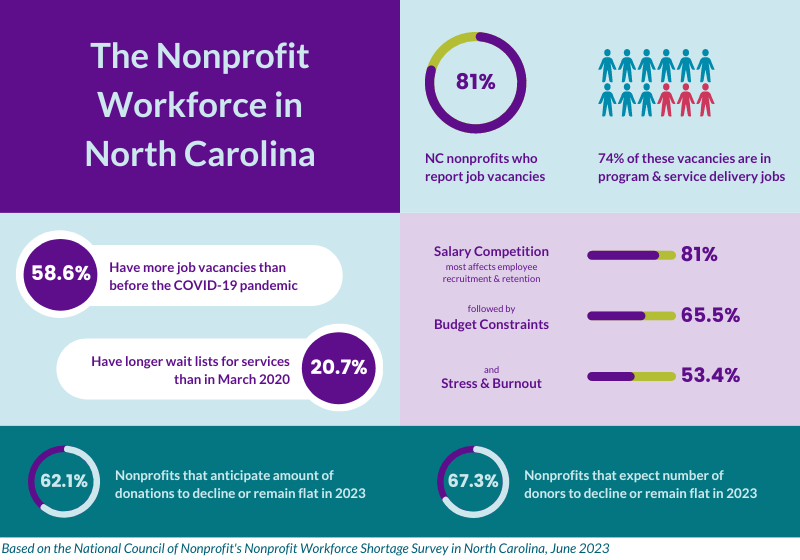In April 2023, the National Council of Nonprofits (NCN) conducted a follow up survey to their 2021 and 2022 findings about the nonprofit workforce shortage to see what, if anything, has changed. The new report shares data and insights from more than 1,600 nonprofits across the US, including almost 60 North Carolina organizations. Although this is a small subset, key findings among the NC responses reflect the larger picture that workforce shortages are still a big issue:
 81% (four out of five) of NC nonprofits reported experiencing job vacancies.
81% (four out of five) of NC nonprofits reported experiencing job vacancies.- 74.5% with vacancies identified program and service delivery as the category with the most vacancies.
- 81% said salary competition most affects their ability to recruit and retain employees, followed by budget constraints/insufficient funds (65.5%) and stress/burnout (53.4%).
- 58.6% responded that they have more vacancies compared to before the COVID-19 pandemic, and 20.7% have longer waiting lists for services than in March 2020.
- 62.1% of NC nonprofits anticipate the amount of donations will decline or remain flat for 2023. A higher percentage – 67.3% – expects the number of donors to decline or remain the same this year.
Why So Many Vacancies?
Turnover happens at any organization, but the COVID-19 pandemic ushered in a broad era of resignations and quiet quitting that has continued. The Pew Research Center found that among the 7 million U.S. workers who quit their jobs in early 2021, the top reasons were low pay, lack of advancement opportunities, and feeling disrespected at work.
NCN’s new nonprofit workforce shortage survey data parallels these findings in the nonprofit sector, showing salary competition, limited budgets, and employee stress and burnout most affecting job vacancies and employee recruitment and retention.
It’s a waterfall effect: Declining donations and decreased numbers of donors limits nonprofits' budgets and their ability to offer competitive compensation. Nonprofit employees with a lot of heart for their missions but salaries and benefits that don’t meet their needs either quit for better jobs or pick up the burden (and stress) of vacant positions and work longer and harder. With consistent or more people seeking out nonprofit programs and services but overworked employees or understaffed organizations to deliver them, wait lists get longer or programs get cut leaving gaps in community safety nets.
How Are Nonprofits Responding?
Accustomed to adapting and evolving, NC nonprofits reported in the survey that they have been responding to the workforce shortages crisis by:
- Increasing salaries
- Increasing benefits
- Providing remote work options
- Distributing one-time bonuses
- Implementing diversity, equity, and inclusion trainings and strategies
- Providing career advancement opportunities
Survey respondents also shared proposed solutions across the sector including:
- More board development for how to properly compensate staff for retention.
- Greater investment in nonprofit staff and a focus on “supporting staff now and getting your people ready for the next job” because this culture will “better attract their replacements in the years ahead.”
- Reforms to grants and contracting practices, including increases in funding rates to cover the actual cost of providing services.
- Non-restrictive funding that covers salaries and operating needs so nonprofits are not pressured to find more funding sources.
Read the complete findings of the Nonprofit Workforce Shortage Survey in North Carolina and the National Council of Nonprofits' full report, 2023 Nonprofit Workforce Survey Results: Communities Suffer as Nonprofit Workforce Shortage Crisis Continues.
